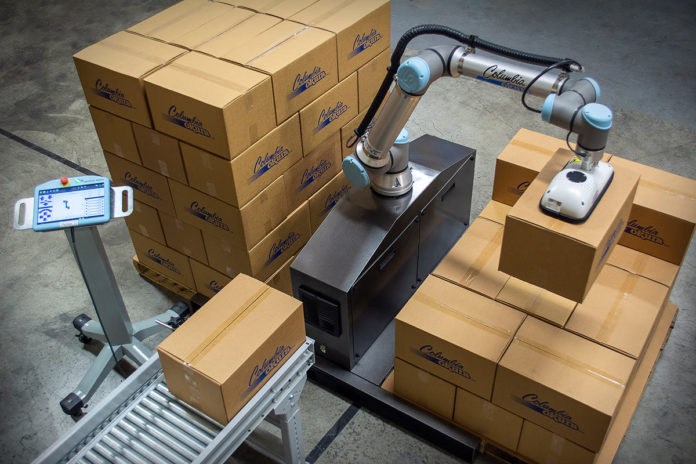If “cobot” has a friendly ring, it’s by design. Collaborative robots have become a relatively low-cost and low-risk solution to a number of manufacturing and workforce development challenges such as skilled worker shortage, repetitive stress injuries, tight floor spaces and more.
Last fall, Columbia/Okura released its first palletizing cobot, a partnership with Universal Robots, which came to fruition in under a year. UR provides the robot arm, and Columbia Okura packages it with a safety mat, Schmalz vacuum end effector, conveyor, steel pallet frame, steel control panel enclosure, software, hardware, safety area scanner and LiftKit base. Aptly named the miniPal by Columbia/Okura Director of Sales Michael Stuyvesant, it’s essentially a plug-and-play palletizing solution for industries that produce and ship smaller and lighter products, such as food and beverage, pharmaceutical and cosmetic.
The main benefit with a collaborative robot is that it is safe to tuck in to a corner of a warehouse floor, and have it working among people. It does not require fencing. If a worker comes too close to it, it slows down its programmed action – referred to as collaborative mode – and if it touches another object or person, it stops altogether. There is a “virtual fence” around it, said Brian Hutton, Columbia/Okura president, and it’s designed for safety.
The miniPAL can be set up in less than a day, can be moved easily from one area of a factory floor to another, and plugs into a standard 110-volt outlet – no additional electrical work is required. While the company is currently sending out a technician to help with installation, it will not be necessary overall, said Hutton, depending on the skill and expertise of onsite technicians. There is also no extra skill needed to work the cobot. However, if a line worker is replaced by it, that worker can be retrained to oversee the collaborative robot, including programming and maintenance.
Programming the robot is done in a web browser, and if you can play a video game, said Hutton, “you are probably overqualified to program the miniPal.”
A miniPal costs just over $100,000, a far lower price point than Columbia/Okura’s other robotic and automated palletizers. And while data is still being analyzed across the cobotics industry, an estimated return on investment is eight to 14 months depending on application and industry, according to materials developed by Columbia/Okura and Stuyvesant.
Hutton said that while he recognized that “cobots were becoming more prevalent” between 2008 and 2018, and a number of Columbia/Okura’s sales representatives had pointed that out, he “still wasn’t convinced because they were for slow-speed, lightweight lines.” Columbia/Okura and its parent company Columbia Machine, both Vancouver grown family owned companies, are known in the palletizing industry for speed and might.
Then a local Universal Robots rep called him to consider collaborating on a cobot.
“I was not too optimistic that it was a match,” said Hutton. Stuyvesant said, “I also had my doubts.” But the partnership would open palletizing verticals that previously Columbia/Okura had too much might to enter.
Stuyvesant refers to the miniPAL as the “gateway to automation” for many companies and cites safety, flexibility and reliability as workforce benefits. “They don’t call in sick – there are no insurance concerns with repetitive injuries.” The UR arm is designed for 35,000 hours before an expected joint failure.
“Palletizing is the least desirable job in a factory,” said Stuyvesant. The material handler or the forklift driver for the line is usually the employee who ultimately operates the cobot, said Hutton. Stuyvesant also consults with prospective customers about how to retrain and retain employees who were previously on the miniPAL’s line.
According to McKinsey and Co.’s July 2019 Industrial Robotics report, more than 100,000 collaborative robots are likely to be shipped in 2020. A new report from Research and Markets said that the “global collaborative robots market is expected to reach $36.84 billion by 2026 in terms of robot systems (including hardware, software and service), representing an astonishing 2019-2026 CAGR (compound annual growth rate) of 44.56%. The hardware market accounts for about one third of the total system market and will grow at 42.21% annually over the forecast years. The annual shipment is expected to exhibit a CAGR of 47.06% during the same period, advancing to 504.54 thousand units by 2026.”
Today at Columbia/Okura, miniPals are created upon ordering. Within a short time, the company intends to have up to three available on the floor for buyers. “Our intent is to have zero lead time,” said Hutton.
Collaborative robots appear to be here to stay. Check out Columbia/Okura on YouTube for video footage of the miniPAL.





